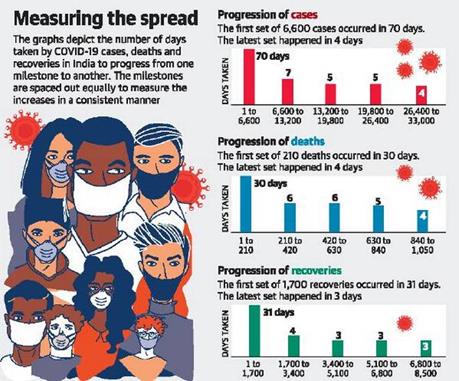DAILY NEWS ANALYSIS 01 MAY
SECURITY
CBI to probe complaint of false Arms Act case
About Arms act:
- The Arms Act, 1959 is an Act of the Parliament of India to consolidate and amend the law relating to arms and ammunition in order to curb illegal weapons and violence stemming from them.
- It allows a person to have three licensed firearms.
- The Act bans manufacture, sale, use, transfer, conversion, testing or proofing of firearms without license.
- The Act specifies the punishment for:
- Dealing in un-licensed firearms, including their manufacture, procurement, sale, transfer, conversion,
- The shortening or conversion of a firearm without a license,
- Import or export of banned firearms.
- The Act also punishes dealing in prohibited firearms (such as automatic and semi-automatic assault rifles) without a license, with imprisonment between seven years and life imprisonment.
- Gun License in India comes under the Arms Act of 1959.
ART AND CULTURE
GI tag to Manipur black rice, Gorakhpur terracotta
About Manipur Black rice:
- Chak-Hao is a black rice variety of Manipur.
- It is a scented glutinous rice which has been in cultivation in Manipur over centuries.
- It is characterised by its special aroma.
- It is normally eaten during community feasts and is served as Chak-Haokheer.
- Also used by traditional medical practitioners as part of traditional medicine.
- It takes the longest cooking time of 40-45 minutes due to the presence of a fibrous bran layer.
Gorakhpur Terracotta:
- It is a centuries-old traditional art form.
- Under it, potters make various animal figures like, horses, elephants, camel, goat and ox with hand-applied ornamentation.
About GI act:
- The Geographical Indications of Goods (Registration and Protection) Act, 1999 (GI Act) is a sui generis act of the Parliament of India for protection of geographical indications in India.
- It was enacted to comply with the Agreement on Trade-Related Aspects of Intellectual Property Rights.
- The GI tag ensures that none other than those registered as authorised users (or at least those residing inside the geographic territory) are allowed to use the popular product name.
- Typically, GI conveys an assurance of quality and distinctiveness, which is essentially attributable to the fact of its origin in that defined geographical locality, region or country.
POLITY
Governor’s Rule in BTAD may impact Assam alliance govt.
Recent Developments:
- Governor’s Rule in the Bodoland Territorial Area Districts (BTAD) has been imposed.
- He will administers the BTAD comprising four districts of western and northern Assam.
Reasons of development:
- The five-year term of the Bodoland Territorial Council (BTC) expired on April 27.
- The elections to the council, scheduled on April 4, were deferred because of the COVID-19 pandemic.
Constitutional provisions of Bodoland Territorial Area districts:
- Bodoland Territorial Council (BTC) was formed under the provisions of sixth schedule of constitution following the 2ndBodo accord in 2003.
- The Bodoland Territorial Council can constitute up to 46 members out of which 40 are elected.
- Of these 40 seats, 35 are reserved for the Scheduled Tribes and non-tribal communities, five are unreserved and the rest six are nominated by the governor from unrepresented communities of the Bodoland Territorial Areas District (BTAD).
About Sixth Schedule and Governor Responsibility:
- The Sixth Schedule consists of provisions for the administration of tribal areas in Assam, Meghalaya, Tripura and Mizoram, according to Article 244 of the Indian Constitution.
- It seeks to safeguard the rights of tribal population through the formation of Autonomous District Councils (ADC).
- ADCs are bodies representing a district to which the Constitution has given varying degrees of autonomy within the state legislature.
- The governors of these states are empowered to reorganise boundaries of the tribal areas.
- She or he can choose to include or exclude any area, increase or decrease the boundaries and unite two or more autonomous districts into one.
- They can also alter or change the names of autonomous regions without a separate legislation.
- Governors of states that fall under the Sixth Schedule specifies the jurisdiction of high courts for each of these cases.
- The roles of the central and state governments are restricted from the territorial jurisdiction of these autonomous regions.
- The councils are empowered to make legislative laws on matters like land, forests, fisheries, social security, entertainment, public health, etc. with due approval from the governor.
Regional councils:
- The Sixth Schedule also provides for separate Regional Councils for each area constituted as an autonomous region.
- Each autonomous district and regional council consists of not more than 30 members, of which four are nominated by the governor and the rest via elections.
EC vague on RTI asking if J&K is in Electoral College
RTI Query:
- Is the Union Territory of Jammu and Kashmir will be part of the Electoral College for the election of the President of India.
Election Commission of India reply:
- For the information, applicant may be informed to refer Article 54 of the Constitution of India.
Constitutional dilemma:
- Under Article 54, the President is elected by an Electoral College.
- It consists of the elected members of both Houses of Parliament and the elected members of the Legislative Assemblies of all the States and also of Delhi NCT and Puducherry U.T.
- Article 54, thus, only specifically mentions NCT of Delhi and Puducherry as eligible to be part of the Electoral College.
- The J&K Reorganisation Act does not specify anything about whether the legislature would be able to vote in the election for a President.

Spend Rs. 65,000 crores for the poor: Rajan
Output of talk of Raghuram Rajan with Rahul Gandhi:
- India needed to open its economy in a “measured and clever way and cannot wait until it has zero COVID-19 cases”.
- India needed to spend about Rs. 65,000 crores to take care of the vulnerable sections such as migrant workers.
- India should now leverage its direct benefit transfer (DBT) network to protect livelihoods and keeping people alive.
- India could mould the international dialogue for a more multi-polar global order.
- There is a strong need for social harmony at this point.
INTERNATIONAL NEWS
Virus was not manmade: U.S. agencies
Observation of US agencies:
- The new corona virus was “not manmade or genetically modified”.
- They are still examining whether the origins of the pandemic trace to contact with infected animals or an accident at a Chinese lab.
- Scientists say the virus arose naturally in bats.
HEALTH
Activists seek testing of Ganga water for COVID-19 treatment
Proposals by the activists:
- The Ganga “could have” anti-viral properties.
- Experimental medicine can be development to treat Covid by undertaking research at upper stretches of Ganga.
Reasons behind the activist proposals:
- Upper stretches of the Ganga had several species of bacteriophages.
- Phages, as they are also called, are viruses that specifically target bacteria and are also extremely strain-specific.
Challenges to it:
- These phages may have anti-microbial properties and could potentially destroy bacteria such as Mycobacterium streptococcus and Pseudomonas Yersinia; it is unclear how phages — being viruses themselves — could have anti-viral properties.
- NEERI has opined that clinical trial on water alone may not yield very useful results
Recovery rate rises to 25%, says govt.

Highlights from government press Conference:
- Fatality rate touches 3.2% with 65% male and 35% female patients;
- Average doubling rate stands at 11 days
- The country is currently recording a total recovery rate of 25.19% up from 13% about two weeks ago.
- The death rate is less than 14% in persons under 45, 34.8% in the 45-60 age group.
- Co-morbidities were found in 78% of COVID-19 fatalities.
- Case fatality for those over 60 years is 51.2% which includes 42% for those between 60-75 years.
- Analysis of doubling rate across the country has revealed that the national average is 11 days presently as compared to 3.4 days before lockdown.
- No health facility should prescribe additional COVID-19 testing for non-COVID patients, causing unwanted delay in treatment for critical patients.
Reference: https://www.thehindu.com/todays-paper/recovery-rate-rises-to-25-says-govt/article31477596.ece
ECONOMY
March core sector output slumps 6.5%

Data:
- Output at India’s core sector contracted by 6.5% in March.
- Index of core industries forms 40% of the weight of items included in the broader Index of Industrial Production (IIP).
- The core industries were a 13% decline in steel output, and a 7% fall in electricity generation.
About Core Industries:
- The data on production of eight core industries of India is published monthly by the Ministry of Commerce and Industry.
- The current base year for the index of the series is 2011-12=100.
- The eight core industries included are- Coal, Crude oil, Natural Gas, Petroleum refinery products, Fertilizer, Cement, Steel, and Electricity generation.
- These eight industries comprise 40.27% of the weight of the items included in the Index of Industrial Production.
What is IIP?
- The IIP is an index used to track the performance of the industrial sector in the Indian economy.
- It does this by mapping the volume of production.
- Index targets a basket of industrial products ranging from the manufacturing sector to mining to energy and allocates different weights to them.
- The index value is then compared with the value of the index in the same month a year ago to arrive at a percentage growth or decline figure.
- The Base Year of the Index of Eight Core Industries has been revised from the year 2004-05 to 2011-12 from April 2017.
- IIP data can be classified based on sectors or use of commodities.
- In the sectoral classification, manufacturing has the highest weight of 77.6%, mining has 14.4% share and electricity has 8% weight.
- Within the use-based classification, data is provided for six categories. These are:-
- Primary Goods (consisting of mining, electricity, fuels, and fertilizers) — this weights 34%
- Capital Goods (e.g. Machinery items) — this weights of 8%
- Intermediate Goods (e.g. yarns, chemicals, semi-finished steel items, etc) — this weights of 17%
- Infrastructure Goods (e.g. paints, cement, cables, bricks and tiles, rail materials, etc) — this weights of 12%
- Consumer Durables (e.g. garments, telephones, passenger vehicles, etc) — this weights of 13%
- Consumer Non-durables (e.g. food items, medicines, toiletries, etc) — these weights of 15%.
Reference: https://www.thehindu.com/todays-paper/march-core-sector-output-slumps-65/article31477598.ece



1.png)
